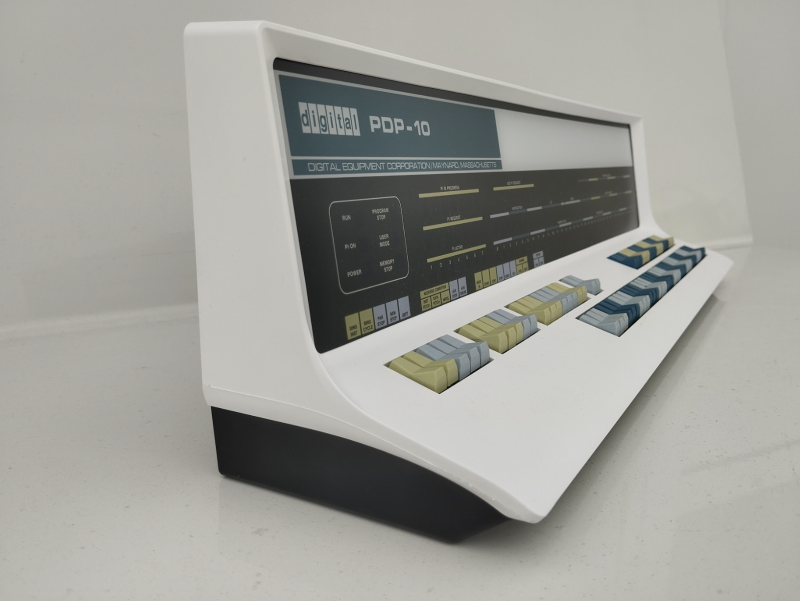Mainframes were actually quite boring machines to work with. You created punch-cards, fed them in, waited, then a response was printed out. DEC’s PDP-10 was the first to be truly interactive. It was DEC’s decision in 1968 to provide a unit to MIT that really sealed its place in history. For the first time, a mainframe became a multi-use computer. Students and staff attached graphics terminals and other displays and started hacking the system. One of the main outcomes from this period was the first computer game, Spacewar! PDP-10s were the first computers to connect via ARPANET, which later became the internet.
Pieces of the puzzle
Oscar’s new project had two distinct parts: The emulator and the hardware. In truth, the hardware is a simple lightboard with some control circuitry. It’s the attention to detail that makes it special. However the software was a bigger problem. Oscar wanted to recreate the MIT experience, and that meant emulating their custom operating system, the Incompatible Timesharing System (ITS). Fortunately, a group was already working hard on emulating ITS, despite MIT having switched everything off in the 1990s. When Oscar met Lars Brinkhoff, the principal driver of the project, the PiDP-10 was born.
Now emulation was taken care of, attention turned to the hardware. Part of the magic of the PDP-10 is its beautiful panel, complete with rows of lights and toggle switches. Oscar was determined to create an accurate replica and found it a satisfying and fun process: “Producing that pretty front panel, with its artwork and transparent windows for the LEDs behind it. That is artisanal work that I really enjoy. Endless tinkering, and then tweaking a big printer to print out the front panels with the exactly correct colours, that sort of thing.”
The injected-moulded case, over 50 cm in width, would be more challenging though. “The problem with injection mould making is – you make a 3D model, you give it to a mould maker, and if you’re lucky he makes a mould to your specifications. Any mistake you made in your 3D model is your problem, there is no going back to fix things.” Luckily, Oscar found a friendly manufacturer who understood the importance of the project and helped him with the process. The result took two years to get right.
The PCB was designed in Kicad, connecting matrices of LEDs and switches to the GPIO of a Raspberry Pi 5, which would be hidden away inside the case. The next challenge was to interface everything together. “Part of the fun is getting the simulator working right. Making sure that it blinks the right LEDs at the right time, that the complex front panel switches for the debugger built into the system really work as they did on the old machine.” explained Oscar. But how to confirm this? Since the mid-eighties there have been no operational PDP-10s. In 2018 Paul Allen, co-founder of Microsoft, who had a strong affinity with the mainframe, tasked the Living Computer Museum in Seattle with restoring an example. Shortly before the pandemic, Oscar was able to see the machine working and fine-tune the emulation to match. Sadly Allen died a few weeks before the restoration was complete.
It was obvious to Oscar that the recreated PDP-10 would be based on Raspberry Pi. A primary factor was cost, as he could see no way he could assemble all the I/O ports and connectors necessary for less than the cost of Raspberry Pi 5, which had everything he needed. Even though the Raspberry Pi does not run a true real-time operating system, it is fast enough to be able to scan the switches and refresh the LEDs two hundred times a second, which is more than enough for accurate emulation.
Two hearts
Oscar also wanted the result to be ‘dual-hearted’. Emulating a PDP-10 and controlling the front panel is a breeze for Raspberry Pi 5, so there’s plenty of processing power available to run other things such as a media server. It’s certainly more aesthetically pleasing than a small black box.
Is Oscar happy with the result? “Yes! In the end, I think the primary motivator for such a project is that you want to have this thing for yourself, blinking away in your living room, and it becomes almost an obsession to Get It Right. And I think we did.” He acknowledges that this has been a project with a lot of contributors such as the ITS Reconstruction Project and many ex-Digital employees, many of which attended the project’s launch at MIT in April.
Best of all, if you’re happy with through-hole soldering, you can have your own PiDP-10! Oscar has put the kit into production and you can order it from his site and build your very own 1960s mainframe. This project has taken seven years, but Oscar is not done yet. Next on the list is the PDP-1 from the 1950s which would complete the ‘evolutionary tree’ of interactive computers. We can’t wait.





